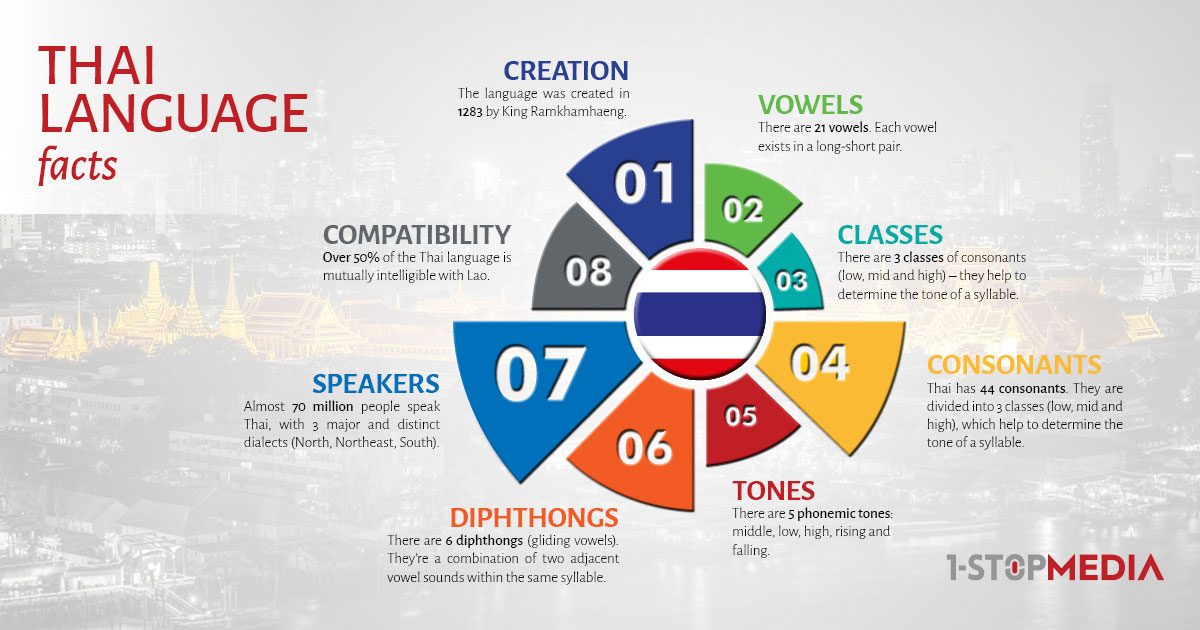Thai Language
Thai is a very challenging language for translators on many levels. This is because of the fact that it is extremely socially sensitive. Everything—including common verb forms—is influenced by the choice of style and address. Thai—also called Siamese—is closely related to Lao. Both use similar alphabets derived from the Khmer abugida (an abugida is like an alphabet except that consonant-vowel sequences are written as a unit) and the languages are mutually intelligible.
The Thai Media Scene
Jumping slightly ahead to the Thai movie scene and the younger generation discussed above (not necessarily at the exclusion of the older generation though), movies are an excellent source of entertainment for them. Dramas, soapies, horror films, animations – you name it, the Thai love it. However, it often happens that most of the time, movies and films are dubbed instead of containing subtitles. Going back to what was said in the previous section, this makes it difficult for Thai people to truly grasp the native way in which a word or a series of words may be spoken, as more focus is placed on one’s listening skills instead of their speaking skills.
Hence the common language errors made by Thais when converting to speaking English. Since cinema is such a great way of introducing a language and culture to a nation, it may be a good idea for Thailand to consider reducing dubbing and introducing subtitles in movies instead. This will greatly help with language uptake.
Language facts that affect English to Thai and to other languages translation:

The complexity of Thai Translation
1. The written language > Translation Service
- Thai translation & localization is as complex as it looks because of the language entailing a deep culture and history, the linguists need to have both cultural knowledge and language expertise in order to produce quality translations.
- The culture: Thai culture can be seen through the language they use, which is full of double meanings, subtle requests, indirect disagreements, and more. There are also words that don’t have a direct translation in English. What’s more, they always finish their sentences with a ‘polite particle’ i.e -ka for women speakers and -krab for men. Thus in order to translate the language well, one must have a full understanding of the local culture.
- The respect: Thai people have different ways of addressing people in the conversation and there are multiple layers of complexity when choosing words; from friends, family, the elderly, teachers, bosses, etc. When speaking to monks and the royal family, they use a completely different set of vocabulary. Seniority is crucial and it must be adequately conveyed in both written and spoken language.
The complex vowels. Thai has 6 diphthongs (gliding vowels). They’re a combination of two adjacent vowel sounds within the same syllable, for example, ชั้น, ซึ่ง, เกี่ยว, หมี่.
2. The spoken language > Media Service
When it comes to Thai translation and localization of the spoken language, the diversity of the language is even more evident. Which makes the translation task even more complicated.
- The dialects and accents: There are 4 distinct Thai accents; namely standard/neutral, Northern, Northeast, and Southern Thai. The neutral Thai is the main accent spoken by most Thais, while the rest vary according to the geographical location of the user. Each accent has a different speed, and many words differ between them. For instance, the phrase ‘It’s ok’ can have a few versions, some of which are listed below:
Standard Thai = ไม่เป็นไร
Southern dialect = ไม่พรือ
Northeastern dialect = บ่เป็นหยัง
Northern dialect = บ่อเป็นหยังเจ้า - The tone: There are 5 tones in Thai, and getting the tone right is important not just because of the accent, but because the meaning can change as the tone does. For example; suay (สวย) means beautiful while zuay (ซวย) means having bad luck or being in an unfortunate situation.
1-StopMedia’s solution for you
At 1-StopMedia we believe that sharing our experience with our clients and partners is an essential part of delivering the services your company needs. We branched out from 1-StopAsia with the single purpose of concentrating on improving our media translation services and creating a flawless and tailored solution for LSPs and large business companies that require media services for Asian languages.
Drawing from over 20 years of experience, we benefit from the skillful and accurate translators we have and at the same time fit our process to match your workflow and requirements. Our project managers are experienced in working with Asian languages, work as per ISO 17100 and ISO 9001 and at the same time can advise you on the type of services your company needs.
Request a Free Quote
We, at 1-StopMedia, are aware that responsiveness and excellent project management are the essence when working within the translation industry.
If you feel it is time to improve your time-management and pay more attention to your clients, get in contact with our Production Team and check how we can help you achieve it.
Ask us anything you need to know about:
- quotes and pricing
- translations and media services
- Asian languages
Start your new project with us today! All you have to do is fill in the form on the right and get your free quote.